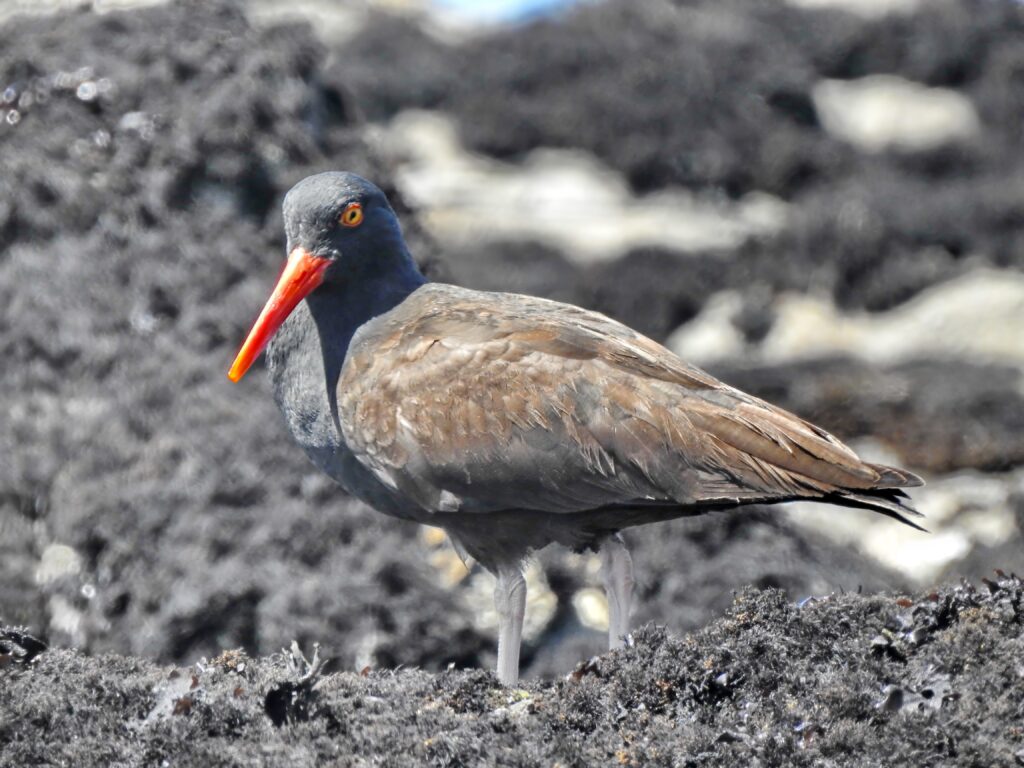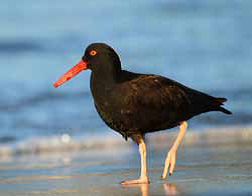by Sasha Greenawalt and Janet Pelinka

If you are startled by a loud, penetrating whistle while tidepooling, direct your attention to where the surf makes contact with the exposed rocks and you will be rewarded by the striking presence of a large black bird sporting a bright orange beak— the Black Oystercatcher (Haematopus bachmani), a large shorebird with a long (9 cm) bright orange bill, pink legs, and a red eyering encircling a bright yellow iris. Its plumage is entirely black.
FMR is a fitting habitat for this unusual bird, as it prefers a rocky shoreline along a coastal stretch with a quiet bay or protected area. It forages in intertidal zones along almost the entire rocky Pacific Coast of North America, stretching from southern Alaska to Baja California. In spite of its name, the Black Oystercatcher seldom eats oysters. Instead, it feeds mostly on other marine invertebrates, especially mollusks such as mussels, limpets and chitons. With sharp jabs of its bill, it dislodges limpets and chitons from rocks, turns them over and eats the soft tissue. Its diet can also include crabs, isopods and barnacles.
The oystercatcher is able to pry open bivalves with ease. These birds sometimes sneak up on open mussels, quickly stab their beaks between the shells, sever the muscle that holds the two shells together, shake the mussel free and swallow it. They forage primarily at low tide and then rest at high tide. The species is for the most part sedentary (non-migrating) and typically mates for life. Oystercatchers have a spectacular mating display: they run along the shore with their beaks turned down or they fly together making loud whistles. When they breed, the pair selects a nesting site above the high tide level and near an area with plenty of food. They make their nests in scrapes placed in gravel, a grassy area, or a depression in rock. They toss rock flakes, pebbles or shell fragments toward their nest bowl with a sideways or backward flip of their bills.
They defend the area against other oystercatchers and intertidal foragers, and use the same nest year after year. Both sexes incubate a typical clutch of 2-3 eggs, which hatch after about four weeks. The eggs are very hardy and can survive being submerged under high water levels.
Downy chicks remain near their nest at first, with one parent guarding the young while the other forages nearby. Eventually, young birds are led by their parents to feeding areas, but they continue to be fed by the adults until after they are capable of flight at five weeks of age.

No population trends are currently available for the Black Oystercatcher, but the global population of the bird is estimated between 8,900- 11,000; more than 50% of that population lives in Alaska. With such a relatively small population size, the Black Oystercatcher is especially at risk from the effects of oil spills and other coastal pollution.
The 1989 Exxon Valdez oil spill in Alaska had a major impact on breeding oystercatchers in that area: 20% of the population was killed directly by the spill and breeding activity was disrupted in 39% of pairs attempting to nest on oilcovered shorelines. This species is also extremely sensitive to the presence of humans on potential nesting islands, or to the introduction of predators such as foxes and rats.

So, the next time you hear that loud, penetrating whistle, look seaward and salute the big black bird.
